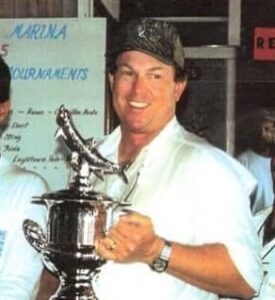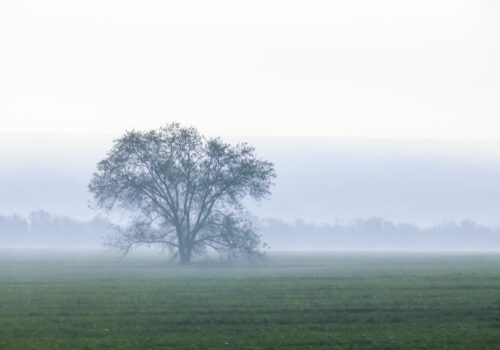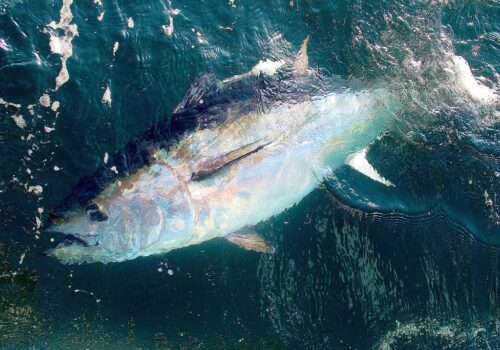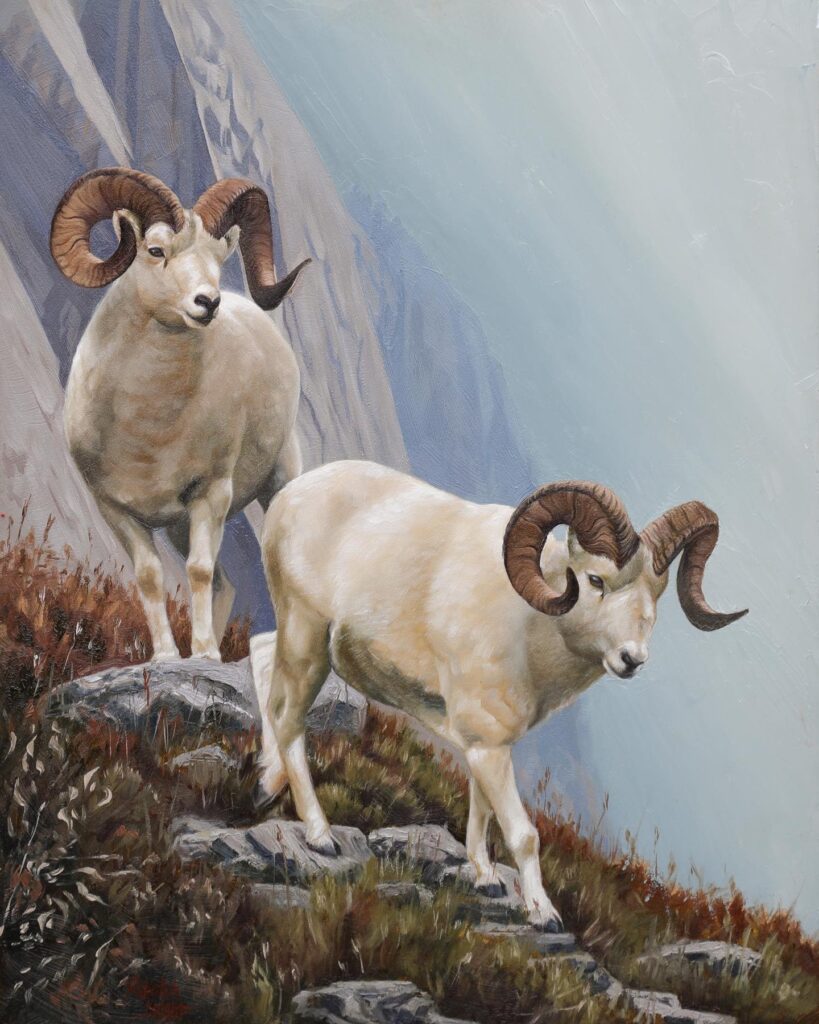
Sheep Hunt for a Flatlander
By Gene White
There in the scope of my .30/06 were the two rams we had seen two days and two mountains back: both past prime breeding age and fine trophies. As I lay there on the side of a grassy mound, I hesitated. Not only for the purpose of taking a careful shot. Many other thoughts raced through my mind. I feared a careless jerk of the trigger, an unknown bump of the scope or the empty click of the firing pin as it hits a dud (that had happened to me on an ill-fated whitetail hunt in Texas).
“Here, lay your rifle on this daypack while I pick out the best one,” Lee interrupted my thoughts. He pulled out his binoculars.
I had been with Lee Trimble in the Yukon Territory the year before but because of a bad fall and a twisted knee I had to cut my sheep hunting short. Later that spring I rebooked with him for August. Although my knee had not completely healed and some mysterious lumps had formed, I knew I had to try again. Because of that leg it was impossible to run to get into shape, but if I could lose fifteen or twenty pounds it would help. On August 16 a slim 180-pound Florida flatland hunter boarded the plane for the three days of flying time to Lee’s allotted area in the Yukon Territory.
The first thing I saw as I arrived in camp was a 42-inch, 14-year-old ram taken by a 72-year-old hunter from Cody, Wyoming. His companion had taken a 36-inch Dall, a nice caribou and a wolverine. Things went well for me also. After two days I had shot a nice 34-point caribou, which scored 350 Boone and Crockett points, in a basin less than two hours from base camp.
The third night Lee pulled out a topographic map and placed it under the kerosene lamp. Moving his fingers over the map, he mumbled repeatedly, “Ewes and lambs here.” On and on, from place to place, he continued his search. After about ten minutes of this he pointed to a spot about twenty-five miles to the north. He looked up with a big smile on his face as if he had found his pot of gold and said, “The rams have got to be here!””
Lee was a man of few words. The previous day he had known we were going to take a caribou in that basin. He moved the map in front of me.
“This is where we will take your ram.”* Lee pinpointed a stretch of country surrounded by glaciers and bordered on the east and north by the Northwest Territories.
To get there would take a full day’s horseback ride and a half-day of backpacking, The area had never been hunted, he said. To his knowledge, no one had even been in there. He should know. He is the only one ever franchised to operate out of this nation.
As we rode there I began to wonder, looking at the steep mountains on either side, whether my knee could withstand the rigors of such a climb. It would have to carry not only my sight, but also a 40-to-50 pound pack. Was this a mistake? Shouldn’t I stick to whitetails when the highest I’d have to climb would be 15 feet up a tree stand? We set up a rough camp for the night, let the horses loose to graze and prepared our backpacks.
Early the next morning (I can’t say before sun-up, since it’s light at 4:00 a.m.) we set out. Beautiful day! The temperature about fifty degrees, clear and sunny. We could not have asked for better weather. It was worth the trip just to be in the country. I felt like Lewis and Clark must have when they opened up unexplored North America. It’s an unforgettable feeling. I am sure Lee felt the same. I could tell he was excited.
Several hours after setting out we had an important decision to make. Some miles ahead the valley split in two. Lee spread out the topo map: many steep mountains to the west, the Yukon-Northwest Territories border was to the east, both arms of the valley winding between glaciers. The short walk would have been to the west. This was my choice. Lee asked my thoughts and I told him. Lee, studying the map, felt that the area to the east would be best. We had only enough food for a few days. The choice was made—we would follow Lee’s route into the mountains bordering the Northwest Territories.
As we started up the valley, we spooked a band of ewes and lambs. Lee had earlier explained that, contrary to widespread belief that ewes, lambs and rams do not inhabit the same country during the summer and early fall, he felt that in this area they did. I wasn’t totally convinced and felt a sense of despair as I saw the ewes and lambs.
I was sure that they had never seen a person since they simply ambled off a few hundred yards and watched us. Then, as we skirted them, there on the grassy mountainside in plain sight was a single horn from a long dead ram.
My spirits revived. It was a horn from a mature ram, measuring about 36 inches around the curl, characteristically thin, and weathered so badly that it was hard to tell how long it had been there. Skull or bones were nowhere to be seen.
Lee hurried me along because the ewes and lambs were watching us and there was no telling what they were going to do. The last thing we wanted was to spook them into flight. It was mid-afternoon before we reached a vantage point from which for the first time, we could see into the virgin country. Sheep trails were all over the sides of the mountains. We had found sheep country, even if it was yet to be determined whether there were rams at hand.
Within minutes after we settled down Lee had spotted some sheep with his scope. On the skyline two animals came into view and even in my ten power binoculars, there was no doubt about them. They appeared to be wearing football helmets. They were rams, and good ones. They were visible only for a minute before they disappeared. They couldn’t have seen us. We were low and off the skyline. The wind was gusting and blowing in their direction, but they were a good four miles away.
We saw seven rams in all on that mountain. The remaining five did not compare to the first two, however, and we discussed the possibilities of a stalk on those two. There was none. All routes were in plain view.
Lee decided we should return to spike camp and come back the next morning, hoping that the rams would stay in the vicinity. Lee was confident; I wasn’t. We were up before it got fully light, hiking up the mountain for that swift, early kill. But after a four-hour climb to where we had first spotted them, they weren’t visible. My spirits were down around my ankles. I pulled out an orange and sucked on it to quench my thirst. Lee pulled out his scope and checked out the surrounding mountains.
He spotted the seven rams but they were in as inaccessible a spot as they had been the day before, halfway up the next mountain on a ledge. The only approach, again, was from the font and below. Glaciers and open country closed off all others. As any sheep hunter knows, this is the worst possible setup. We talked about going home, but we knew this would be the only chance we would have at these or any other sheep.
Perhaps later in the afternoon they would get up to feed? If they did, once the sun was at our backs, we could sneak off the mountain and approach on our bellies. We might have a chance. Talk about a long shot! But it was the only shot we had. After seeing those two buster rams I couldn’t leave them without at least giving it a try. If we tried for them, whether we connected or not, it would mean a cold night away from our gear.
We decided to go for broke. We would sit tight and figure out the best approach. Since we had several hours to wait, we put the spotting scope on the sheep and drooled. The old timer was higher and more inaccessible than the rest. He would occasionally lay his head on his front legs and snooze. He had heavy horns with an argali-type curl. The curl went down to the bottom of his jaw, then angled and flared out. The tips were not of the typical thin Dall ram type, but nice and heavy. No, I couldn’t leave without at least giving him a try.
Four to six agonizing hours later the young ram got up to stretch his legs and feed. Within a half hour they were all up and tasting the mountain goodies. It was time for us to roll the dice. We eased down the mountain, crossed a ravine and a river bottom on our knees when the rams fed or looked the other way.
Hours later, cut, bruised and nervous, I lay watching the two fine rams. A recuperated hunter, a good rest, a clear sight-picture, a slow squeeze of the trigger put him down, majestic, even in death.
As I watched the other ram leave I began to wonder whether I had not taken the wrong one. Lee, apparently reading my mind, picked up the head of the ram on the ground. Then I knew I hadn’t taken the wrong one. He was twelve years old and full curl plus.
We would not make it to our camp that night but under the circumstances you don’t think of such things. You admire the trophy. You relax and realize where you are and what you have accomplished. You absorb the thrill of this high mountain meadow in the twilight and the forty-inch, twelve-year-old ram at your feet. You don’t think of the cold, the lumps in your knee, etc. This is a time for celebration, reflection.
The ram would no longer walk the mountain. He would no longer experience the trek to the mating ground. He would no longer suffer the hardships of winter.
He would not face slow, agonizing death in the frozen Yukon, nor the humiliation of aging. Wolves would not tear his entrails. He had died a magnificent death in his prime—leader of a band of rams, he had died in his bed.
Lee pulled out a rumpled lunch bag which he used as a measuring standard. Evidently he had done this before Later actual measurements showed the sandwich bag hadn’t been too far off: the horn was 38% inches. (If you try this, make sure the bag hasn’t been used five times!)
I can’t say enough about Lee and Mary’s area, or their hospitality. I highly recommend the area, which Lee and Mary have recently sold to an experienced guide from Gary Powell’s camp out of Fort Nelson, British Columbia, named “Cap.” I have hunted with him in Gary’s area for trophy elk, and I know he will continue the fine game management practices the Trimbles insisted upon.
This hunt was published with permission from Gene’s book “Big Game”.

Gene White
is a Floridian who is as comfortable in the courtroom as a lawyer as he is in the field or on the water as a sportsman. Decades of adventures later, he would tell you his proudest achievement is the family Sally and he have built together.


You May Also Like

Eternal Echoes: A Haunting Hunt
October 23, 2023
“I’ll Have A Double!”: Holiday Party
November 21, 2022

